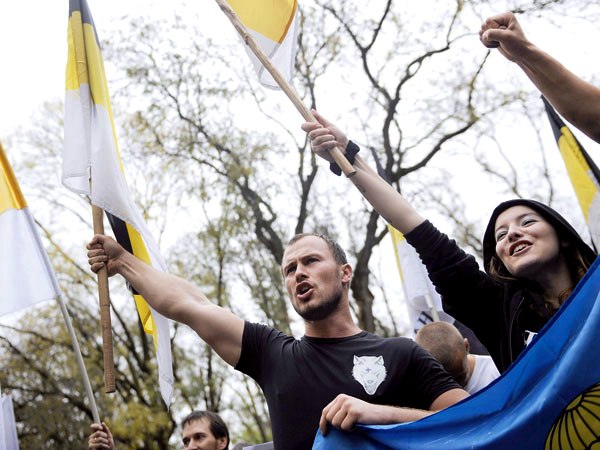
Non-Traditional Threats to Sochi
Publication: Eurasia Daily Monitor Volume: 11 Issue: 18
By:

The recent warning from the US State Department not to wear patriotic clothing outside of the “ring of steel” in Sochi proper might have been thought to forestall an attack from Islamists. But there are many other “non-traditional” threats to foreign visitors to the Winter Olympic Games. Precisely because of the Islamist threat, these other threats have not received the attention they deserve.
First, the threat posed by extremist nationalists and racists in Krasnodar Krai surrounding Sochi is a real and significant one. The region has a history of racist and anti-Semitic rhetoric from its former governor Nikolai Kondratenko and current governor, Alexander Tkachyov. Indeed, Tkachyov is currently being investigated by the Russian United Democratic Party “Yabloko” for racist comments he made in 2012 regarding the use of police forces to “flush out” ethnic Caucasians from the region (https://mosmonitor.ru/news/society/sledstvennyiy_komitet_proveryaet_gubernatora_tkacheva_na_ekstremizm). Tkachyov is also at the center of the controversy surrounding systemic violence and intimidation directed against the Meskhetian Turks, which led, in part, to their en masse evacuation in 2004 from Krasnodar Krai (see EDM, November 27).
Moreover, it is not just rhetoric from the governors. Nationalist gangs are also highly active in the region, and on the night of December 20, 2013, a group presumed to be skinheads hung a pig’s head over the entrance to a Jewish community center with a banner that read in English: “happy Tu V’Shvata, Jewish Pig” (https://www.sova-center.ru/racism-xenophobia/news/racism-nationalism/2013/12/d28686/). Neo-Nazis in Krasnodar also participated in the “Russian March” in 2013, with estimates ranging from 150 to 1,000 people (https://www.sova-center.ru/racism-xenophobia/news/racism-nationalism/2013/11/d28355/). Racists in Krasnodar are a threat to people wearing patriotic clothing from other countries—and especially a threat to athletes or tourists of different races.
The threat of racist incidents is compounded, moreover, by the revived “neo-Cossack” movement in the region. Indeed, Governor Tkachyov created Cossack brigades to help prevent the “expansion” of people from the Caucasus in his region, despite restrictions on the movement of other Russian citizens being illegal under the Russian constitution (https://www.svoboda.mobi/a/24667607.html). The Cossacks were heavily involved in actions against the Meskhetian Turks and, before 2004, used violence to help convince them to leave.
Some 400 Cossacks have been effectively deputized by the regional authorities and brought into Sochi to help provide security during the Games for “sportsmen, foreign delegations, and tourists” (https://ria.ru/sochi2014/20140109/988327449.html). The conscripted Cossacks are unlikely to pose a direct threat to the safety of foreigners. However, it would not be a surprise if those Cossacks outside of the so-called “ring of steel” become emboldened by the actions of their compatriots to boost their own zeal in monitoring presumed threats to security beyond the immediate area around Sochi.
Both of these threats would be further heightened by the occurrence of a successful terrorist attack anywhere within the Russian Federation. Indeed, there were signs of a nationalist counter-mobilization in the city of Volgograd following the bombings there (see EDM, January 16). The massing of extremist nationalists was put down by authorities before any serious damage could follow from it. Yet, given that the authorities in the region will presumably be occupied with preventing further terrorist attacks—not to mention the general chaos that would ensue—the next counter-mobilization may be more successful. Similarly, the Cossacks may pursue their own vigilante justice. There are already reports that Russia’s Cossacks and Neo-Nazis have been working together, including for the street rally (skhod) in Volgograd on December 30, 2013, that followed the suicide bombing in that city (https://www.sova-center.ru/racism-xenophobia/news/counteraction/2013/12/d28747/).
The final “non-traditional” threat to foreigners outside of the Sochi protected area comes in the form of organized crime. Krasnodar has long had a reputation as one of the most lawless areas of the Russian Federation—a dubious honor that the Khruschevksaya massacre in 2010 seemed to confirm (https://www.kavkaz-uzel.ru/articles/220275/). In that brutal incident, 12 people, including women and children, were killed—some after having been raped—by the local Tsapok gang. The massacre highlighted the network of interconnections between local businessmen, criminals and the regional political administration. The gang had avoided prosecution for earlier crimes due to their close links to high-ranking regional officials. It is not outside of the realm of possibility to imagine such criminal elements kidnapping foreigners with the aim of extortion.
It is also worth noting that all of these three non-conventional threats are even more likely to take place during the Paralympic games (which follow the regular Olympics immediately) for a number of reasons. First, the world will not be watching as intently—rightly or wrongly, the Paralympics typically draw less attention. Second, the disabled are subject to frequent attacks in Russia even from people not obviously aligned to Neo-Nazi movements, such as the one on January 28 in Magnitogorsk (https://chel.kp.ru/daily/26054/2965130/). Third, the disabled are likely to be “softer” targets because they are more vulnerable, especially in Russia where disability access to most buildings is not a priority for planners. It is perhaps an indictment of the wide range of dangers to the Sochi Olympics that such threats can be considered “non-traditional.”




